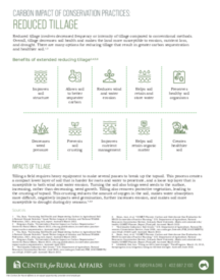Reduced tillage involves decreased frequency or intensity of tillage compared to conventional methods. Overall, tillage decreases soil health and makes the land more susceptible to erosion, nutrient loss, and drought. There are many options for reducing tillage that result in greater carbon sequestration and healthier soil.
Tilling a field requires heavy equipment to make several passes to break up the topsoil. This process creates a compact lower layer of soil that is harder for roots and water to penetrate, and a loose top layer that is susceptible to both wind and water erosion. Turning the soil also brings weed seeds to the surface, increasing, rather than decreasing, weed growth. Tilling also removes protective vegetation, leading to the crusting of topsoil. This crusting reduces the amount of oxygen in the soil, makes water absorption more difficult, negatively impacts seed germination, further increases erosion, and makes soil more susceptible to drought during dry seasons.
See more: No-till | Extended crop rotation | Cover crops


